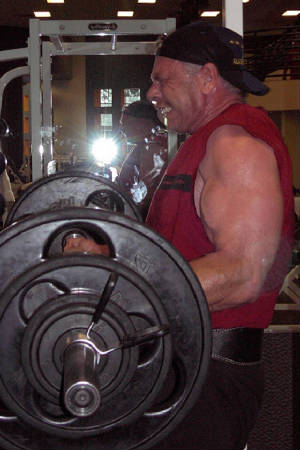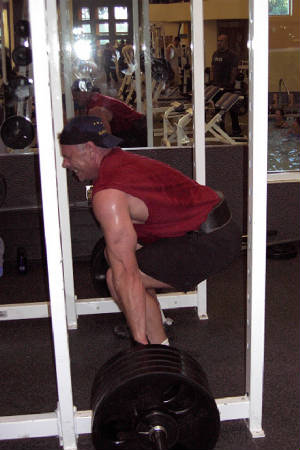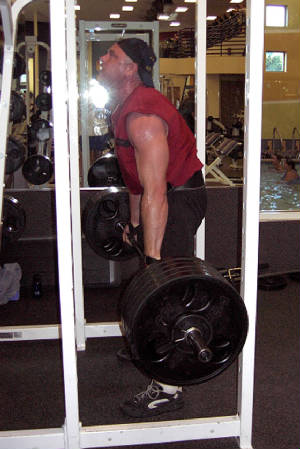|
Message Board with Training section- and due to several requests of James Vandervests' actual workouts!
http://p199.ezboard.com/bintencemansmuscleforum
High Intensity Training Tips



Training in the gym (at a bodyweight of 247 lbs)
| Intensity |
|
|
| Intensity is the key to muscle growth and fast results |
Genetic Potential
When trying to assess how far you can go, that is to say how big and strong one can get, its somewhat hard to say as
this is a genetic limit and its an individual thing, which can only be accurately assessed in retrospect. Some things to look
at are:somatotype- are you all ecto- or ecto-mesomorph, etyc, skeletal structure, length of the muscles themselves- the longer
the muscle the greater its potential cross-sectional can be, muscle fiber density- - the more the better, etc.
As to just
one example, I'm 6''3" and have been training for quite a few years. I started out as ecto mesomorph.
Here's what I achieved
to date.
Goood Luck and train hard,
James
Training, Cardio, Protein, Carbohydrates and Glycogen levels
If I'm dong only cardio that day, I don't eat for at least 2 hours pre cardio. I want my blood sugar a bit low, and a
little low on gylcogen so that the body will go into fat burning mode easier. I will then eat -protein, carbs etc when I get
home to replenish the glycogen stores for the next days' weight session.
If I am weight training then doing cardio, I make
sure I've had a good amount or protein and carbs within a few hours of training to fuel the high intensity contractions. By
the time I've finished my weight workouts and do my cardio session, I've burned up a lot of muscle glycogen and glucose and
again its easier for the body to go into fat burning mode.
James
Partial Reps
I do partial reps as an adjunct-
never a substitution for full range training. Arthur Jones did a study of strength curves and found there are two types of
individuals- type G and type S. In the G type, although when only partials were
done, these individuals gained a lot of strength in the partial range, full range training was found to be necessary, as there
was very little to no transfer from the partial to full range strength. In the other type S, these individuals displayed transfer
of strength gains from the partial to the full range. This was a considerably SMALLER segment of the trainees. (Ronnie Coleman
might fight into this category, but as seen above, what is good for him, is NOT necessarily good for the rest of us.
The "Spillover" effect
This concept derives from some GREAT advice I read a few years ago which really
helped me improve. If you want bigger arms- work your back and legs hard. WHAT? you say?. Here's the reasoning- whenever you
stimulate a muscle to grow, it has a secondary effect on stimulating other muscles in the body to grow, the bigger the muscle
stimulated- the bigger the effect. Legs being the largest have the greatest "spillover" affect. Back being second, etc. also
working back hard realy workes the biceps hard- If you can curl 100 for reps and row 200 for reps- that 200 is going to "overload
your biceps I do little direct arms work- 2-4 sets for bis and for tris, but up to 7 or 8 "working sets" for back and around
the same for legs. Try working biceps once a week after back ammd triceps with your pulling muscles to elimminate excessive
"overlapping" which can interfere with your recovery. Good Luck!
|
|
Negatives
Negative resistance can be a highly productive training method if used
properly. To understand how negative resistance is important, remember that there are 3 types of contraction that skeletal
muscles can undergo. The first is positive or concentric contractions- these are when you are contracting the muscle, ie lifting
the weight. The next is static or isometric contractions. This is simply holding the weight or contraction at the point of
maximum contraction- typically the top of the movement. The final type of contraction is the negative or eccentric contraction-
the lowering of the weight. Exercise scientists have demonstrated that the eccentric phase is responsible for most, if not
all, of DOMS- the soreness that sets in 48-72 hours after working out.
It is hypothesized that more muscle damage (tearing down-microruptures
of cells and membranes) occurs as a result. The implications are clear-negative training can be a more intense stimulus,
but must be used judiciously to ensure repair, recovery and supercompensation. It is recommended that negatives be used no
more than once a week for a muscle or muscle group-less for those with lower exercise tolerance.
Intensity
It is essential if you want to make optimal gains to carry each set to at
least a point of momentary muscular failure. This is the point where, despite your greatest effort, perfoming another full
repetition is impossible. Carrying your sets to this point of failure ensures that you have stimulated growth. Training beyond
failure with intensity variables such as forced reps, preehaustion, and negatives with further increase the intensity of the
exercise. Be careful! For every increase in intensity, there is a deeper inroad made into your recovery ability, thus making
the likelihood of overtraining ever greater.
Copyright © 2004 James Vandervest
|
|

